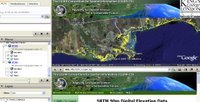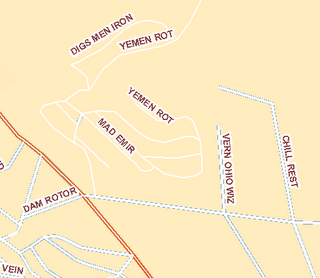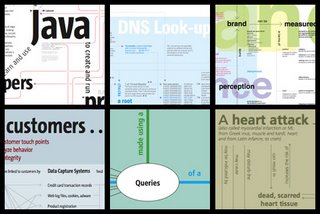
Do Not Pay for Free Data many thanks to Glenn and his GIS Data blog that focuses on where to get free geographic data via the web. It is well organized and a required stop before I start any project. Keep up the great work Glenn!
Sunday, October 22, 2006
Posted by Ken H. at 9:48 AM 1 comments
Friday, October 20, 2006
New! Video Tutorial - Excel to ArcGIS 9.1
Since sending video over the web has not only become extremely simple, but almost the new standard, we've decided to produce our very own ArcDex GIS video tutorials. This first video goes through the steps of connecting an Excel spreadsheet to ArcGIS 9.1. The intent is to help us all appreciate the new Excel functionality in the upcoming 9.2 release :).
I'm not too happy with the way the flash video distorts most of the desktop images. In the future maybe I'll try Quicktime format instead, but for the sake of considering the fact that not everyone has Quicktime installed, let's see how this works out.
Posted by Ken H. at 8:38 AM 3 comments
Thursday, October 12, 2006
Laguna Beach Map Remix

Using Wordsmiths anagram engine I set out to rename a majority of the names of LB streets. While going through these, I found some shockingly relevant phrases coming to light. Phrases relating to the war and tensions in Middle East, for example, Oman Did (Diamond St), Octane Visa (Ocean Vista Dr), Iran Mock Corny (Rim Rock Canyon). And the most sinister phrase I found: Iran Bush GoGo (Gainsborough). Could the secrets of today’s political scene deepest questions lie in the streets of the Real O.C?
I was also amused by some of these: Blue Bird Canyon is an anagram of Crabby Oiled Nun, while Canyon Acres could Scare Any Con(servative?) perhaps?
A full version in PDF format can be downloaded here (its big - 36x48)
Download the shapefile for the remixed roads here (zip file, remixed names are in field N9)
Note: Some phrases may be objectionable to some readers. Keep that in mind.
Posted by Ken H. at 10:49 AM 0 comments
Tuesday, October 10, 2006
Maps of War: 3000 BC to 2006 AD
I didn't really pay to much attention to European History in High School. So I'm thankful for this quick review from the Maps of War Imperial History video.
I am really hoping that the ArcGIS 9.2 release can handle this kind of video as well.
Posted by Ken H. at 11:25 PM 2 comments
Friday, October 06, 2006
Using Google Code Search for ArcGIS
Google Labs has recently announced the unveiling of its' newest creation - Google Code Search. Code Search indexes publicly available code - which is then available to you via their search engine. This should be very helpful for all you custom programmers out there.
I tried out the simple query of ArcGIS and got back a couple of interesting results. One of which being a Python script for exporting the ArcGIS table out to mySQL. Right above that result was a script written in C that creates cartograms.
Have any better ideas or search strings that will maximize the use of Google Code Search in GIS? Please share them in the comments section.
Posted by Ken H. at 9:55 AM 1 comments
Wednesday, October 04, 2006
Massachusetts Tollbooth Locations in Google Earth
One of the best government GIS sites has to be the State of Massachusetts MassGIS portal. They have a ton of shapefiles for almost anything you could need, plus building footprints for the city of Boston. Here is a Google Earth KML we file created from the MassGIS 'Tollbooth' layer which shows the locations of interstate tollbooths in the Bay State. 
By providing this kind of base data, it allows for anyone to create additional value added products. By displaying this in Google Earth, we can share the shapefiles with users that would never load a true GIS package.
What experience have you had with other States? Perhaps you could share your info in the comments section.
Shapefile Source: Office of Geographic and Environmental Information (MassGIS), Commonwealth of Massachusetts Executive Office of Environmental Affairs
Posted by Ken H. at 11:55 AM 0 comments
Tuesday, October 03, 2006
Increasing Federal Markets for GIS
The Federal Government has been a huge GIS consumer for years. That’s no secret. They are one of the few agencies that can afford a full deployment of GIS software. But it’s good to see that they are continuing to rely on and emphasize GIS and spatial technology. The “Google Earth Effect” seems to have permeated the newest transportation re authorization bill and other planning doctrines. This new bill requires that visualization takes place during the planning stages of a project. And the bill specifically mentions using GIS to show what the project would look like after it is built.
The FHWA and the FTA recognize that there are myriad ways to use
visualization techniques to better convey plans and programs and there
are wide variations among MPO capabilities and needs, especially
between large, established MPOs and small, new MPOs. States and MPOs
may use everything from static maps to interactive GIS systems, from
artist renderings and physical models to photo manipulation to computer
simulation. Visualization can be used to support plans, individual
projects or Scenario Planning, where various future scenarios are
depicted to allow stakeholders to develop a shared vision for the
future by analyzing various forces (e.g., health, transportation,
economic, environment, land use, etc.) that affect growth.
Posted by Ken H. at 10:15 AM 0 comments
Tuesday, September 26, 2006
Global Competitiveness Report in Google Earth
Here's another Google Earth file with some current geospatial data. The World Economic Forum has released its 2006/2007 report which attempts to model the process of growth using all the complicated factors that affect countries. The U.S. has slipped. From 1st to 6th based on war and security spending.
If you already have Google Earth installed, check out the data by clicking HERE.  ken@stolasgeospatial.com
ken@stolasgeospatial.com
Posted by Ken H. at 1:58 PM 0 comments
Saturday, September 23, 2006
Weekend Video - Man Behind the Maps Part II.
2nd installment of Billy McWilliams doing his part to keep Google Maps up and running.
Posted by Ken H. at 1:20 PM 0 comments
Friday, September 22, 2006
National E. coli Reported Cases Map in Google Earth
The FDA continues its crackdown on fresh spinach in hopes to bring an end to the current E. coli H157:H7 outbreak. On 9/21/2006 they released the number of illness reports per state.
We've created a simple thematic KML layer showing the number of reported cases per state for a client. Click HERE to open the KML file in Google earth to see the breakdown data (you must have Google Earth installed.)
E. Coli | Spinach | FDA | Google Earth
Posted by Ken H. at 1:49 PM 0 comments
Wednesday, September 13, 2006
Geographic Spellcheck Strategy
I've grown tired of my Word spell checker constantly showing red underlines on my street names in Office documents. It would take months to type in all the road names into the dictionary if I wanted to use them during spellcheck. Then I realized I had a entire database of street names right in my shapefiles.
So I set out to create a Word custom dictionary in these steps:
1. Save out the road centerline file to DBF.
2. Open the DBF in Excel and delete all the columns but the road name.
3. Save As Tab Delimited.
4. Open in Word and make case changes (if necessary).
5. Copy the data into a Wordpad file. Save with a .dic extention.
6. Load the custom dictionary in Word! Viola!
Now I think I am going to do waterbodies, rivers, railways, airports, etc.....
Posted by Ken H. at 2:42 PM 1 comments
Tuesday, September 05, 2006
Concept "Maps"
O.K. So these are not true geographic maps, but I think the design can be applied to cartography just the same. Applying some of their principles when presenting Metadata or Schemas would make for an awesome display board.
We develop a range of diagrams and maps to create, test, and refine architectures or organizational structures for the applications and sites we design. Maps created as design tools serve many of the purposes of maps created during audits — creating shared models for the team, uncovering problem areas, and serving as a reference for product managers and engineers.The examples come from Dubberly Design Office, via LifeClever. They are really sharp!

Posted by Ken H. at 7:34 AM 1 comments
Monday, August 21, 2006
Trimble GeoXT Note
Well today I dusted off my trusty 'ole Trimble GeoXT. Unfortunatly, it's been mothballed since December. Just didn't have any projects for it.
Well when I fired it up it went into some kind of mandatory 15 minute charge up mode. After that, I tried to start up ArcPad 7. Nothing. Couldn't find it anywhere in the system. Well, it took a full re-installation and sync to get back up and running.
Not sure what the technical aspects are of this, but I'll never let this thing get that run down again. Now I'm headed outside (finally - it's 75F and breezy.)
Posted by Ken H. at 3:23 PM 0 comments
Wednesday, August 16, 2006
After geospatial blogs were totally overlooked at the ESRI 2006 Users Conference, I was excited to see that there would be an article about such blogs in the Jul-Sep 2006 edition of ArcUser magazine. But, in the end, I was un-fullfilled (once again :) ).
I think the main reason for this disappointment in the article was the discussion of the extreme basics of the technology that bring us blogs, and not focusing on content. On page 30 we are talking about object model diagrams and cursors for arcobjects, then we move along the line a couple of pages to the definition of a "podcast???" Consider your audience here. And good luck finding something on PubSub - use Google Blogs or Technorati search engines to find something useful.
Lastly, the authors only plug their own website and like one or two more (3 of which are aggregators and not blogs). Not that the following blogs need any plugs, but here are a few that I thought would be no brainers to talk about or maybe even get interviews with:
Posted by Ken H. at 1:13 PM 1 comments
Tuesday, August 15, 2006
ESRI Tools At Different License Levels
One thing that drives me crazy is forgetting that I have ArcInfo and then distributing models to ArcView users who cannot use them. I really wish there was some type of color code on ArcToolbox that would remind me that its a ArcInfo only tool. Well until that happens, I've been using this file from the Online Help.
You may also find it helpful.
Posted by Ken H. at 11:17 AM 0 comments
Monday, August 14, 2006

Where 2.0 Conference Presentation Files
The presentation files (PPT) are now up at the Oreilly Where 2.0 conference held back in June 2006. There are alot of good topics that I am saving for review, after I try out some of the new tips and tricks learned at the recent ESRI UC. Can't absorb too much in such a small time frame!
Posted by Ken H. at 8:12 AM 0 comments
Saturday, August 12, 2006
It's a Wrap - 2006 UC
Well the curtains have come down once again on another ESRI users conference. Overall, I think it went great, but the format and topics are getting a little stale. Kudos to the San Diego Airport TSA staff - when we got to the airport at 9AM there was NO ONE in line for security! I am sure we all were thinking about the world events as we flew out on Friday. I felt very safe without being inconvenienced.
There are a couple of wrap up items out there you might want to check out:
- James Fee's reflections on the conference
- A new Video Blog emerged called GIS Nation - <
> - What's new in ArcGIS 9.2
- ArcGIS Explorer movie demo
- ESRI Touchtable Demo
- Be sure to register for a 9.2 demo in your state here
Posted by Ken H. at 10:10 PM 0 comments
Wednesday, August 09, 2006
2006 UC Photos....
This photo is of the 1/4 scale elevation map of British Columbia. Glenn over at AnyGeo has a good write up about it. Seeing the natural curvature of the earth on this display makes it a must!

Posted by Ken H. at 2:56 PM 0 comments
Tuesday, August 08, 2006

Animation Tools in ArcGIS 9.2
Live from the UC conference here in San Diego, I just watched a great demonstration using a new tool called Animation. The demo just showed population change over time in the northeast portion of the United States. Now instead of having to print out maps for each decade, the symbology changes as the values change. The animation can then be exported out to mov or avi's.
I can imagine that over the course of a year, this will be a tool that is greatly utilized for Planning Commission meetings, and the such. I went over to the ArcGIS Explorer display to see if they could take in Animation features into Explorer, but the answer was no.
Posted by Ken H. at 4:13 PM 2 comments
Tuesday, July 25, 2006

Google Earth Effect
Today the All Points Blog featured a column in the Belfast Telegraph talking about satellite photos of a Pakistani nuclear reactor under construction. But it wasn't disclosed by some secret defense analyst, the images were found on Google Earth.
APB notes that the article makes mention of the "Google Earth Effect" popping up in several places around the web. I think that this so-called 'effect' is just viewers seeking consumer level aerial photography, and in a hurry. There will come a time when images used in the media will be near-real time, to include before and after scenes like those in the Katrina analysis.
But this GE Effect will not lead more users to embracing commercial GIS. I am sure that people don't realize that GE is the MS Paint of the GIS world.
And I don't know why the media isn't ready to start doing real time geostatistical analysis on the air. Here in Michigan, they proposed a making it a rule making it illegal for a convicted sexual offender to live within a 1000 foot buffer around a school. Sounds great on its face. But when I threw a quick 1000' buffer on a map around schools in my area, I realized it only affected about 10 homes around the school: and a rule like that would be theoretically ineffective. But I guess that wouldn't be a popular position to take.
Posted by Ken H. at 10:47 AM 1 comments
